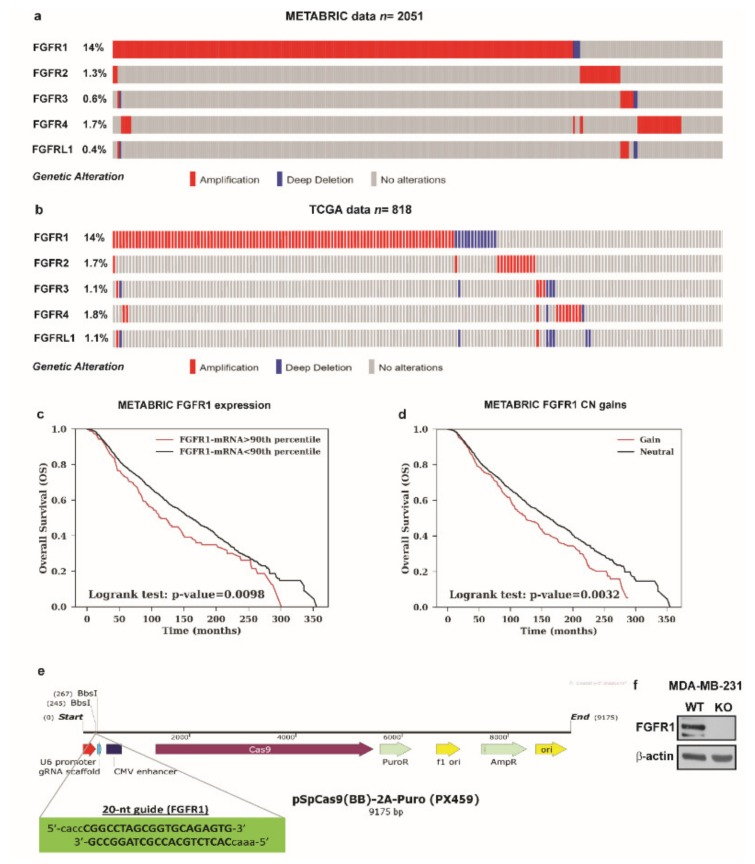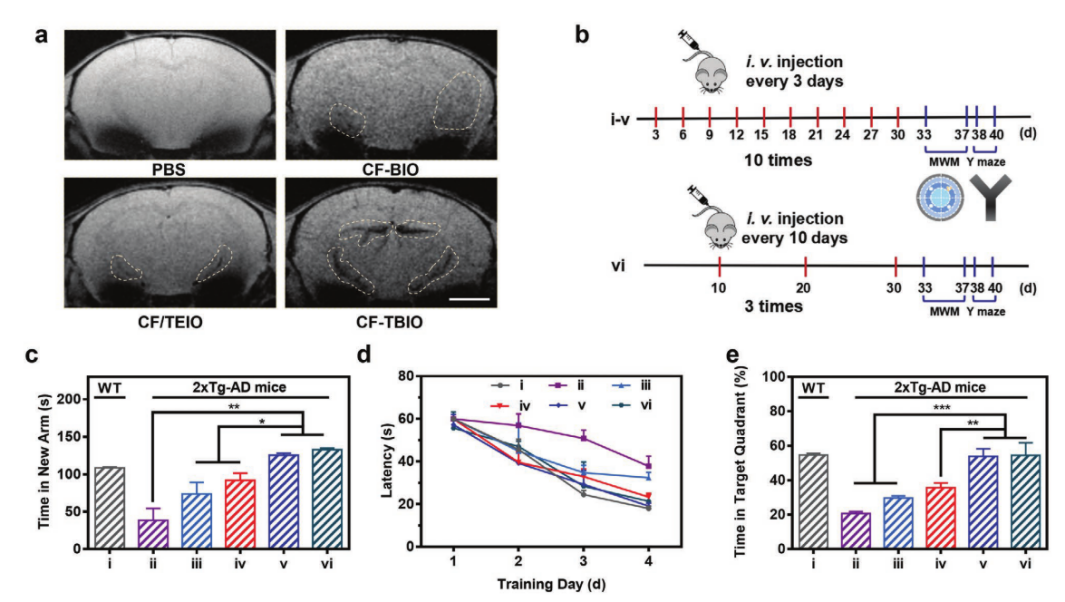【Cutting-Edge News】New Trends in Gene Editing - FGFR1, BRD4, and BACE1 Knockout Cells

Gene knockout cells refer to the utilization of CRISPR technology for gene editing. By designing specific sgRNA to target the cleavage site of the gene of interest, the Cas9 protein is able to bind with the sgRNA and "excise" the target gene from the cell, thus achieving gene knockout. Gene knockout cells have broad application prospects in the fields of life sciences, medicine, and drug development. For instance, they can be used to establish disease models, conduct drug screening and target validation, and knock out pathogenic genes for gene therapy of diseases. In this article, we present an interpretation of three relevant studies on gene knockout cells, aiming to introduce you to the latest advancements in this cutting-edge technology.
I. Verification of FGFR1 Gene Knockout to Explore the Specific Role of FGFR1-ERK1/2-AKT Signaling Pathway in Breast Cancer Cells
Original Source:https://doi.org/10.3390/cells8030223
The fibroblast growth factor (FGF) - fibroblast growth factor receptor (FGFR) signaling axis is one of the principal pathways mediating interactions between the tumor stroma and cancer cells. The activation of FGFR1 can lead to cancer progression through translocation, point mutations, or amplification of the FGFR1 gene. Additionally, the G protein-coupled estrogen receptor (GPER, GPR30) has been identified as a receptor mediating the effects of estrogen under various pathophysiological conditions.
To investigate how GPER mediates communication between cancer-associated fibroblasts (CAFs) and breast cancer cells through the FGF2/FGFR1 signaling axis, researchers utilized CRISPR/Cas9 gene editing technology to knock out fibroblast growth factor receptor 1 (FGFR1) in MDA-MB-231 breast cancer cells. In normal control groups, conditioned medium (CM) from estrogen-stimulated cancer-associated fibroblasts (CAFs) induced the expression of CTGF (connective tissue growth factor) in wild-type (WT) MDA-MB-231 cells and promoted cell migration and invasion through the FGFR1-ERK1/2-AKT signaling pathway. However, this induction was significantly reduced or absent in MDA-MB-231 cells with FGFR1 gene knockout. The study of FGFR1 gene knockout cells revealed a novel role for GPER in regulating FGF2 expression within the tumor microenvironment. It confirmed that FGFR1 gene amplification in breast cancer is closely associated with overall patient survival rates, suggesting that FGFR1 may serve as a therapeutic target for breast cancer. This research elucidated the paracrine activation between CAFs and breast cancer cells, providing a theoretical foundation for developing new treatment strategies.

Figure 1: Analysis of METABRIC and TCGA Datasets in MDA-MB-231 Cells and CRISPR/Cas9-Mediated Knockout of FGFR1
II. Identification of Novel Key Oncogenic Proteins in Cutaneous Squamous Cell Carcinoma through BRD4 Gene Knockout Cells
Original Source: https://doi.org/10.1016/j.cellsig.2017.10.010
In recent years, the incidence of cutaneous squamous cell carcinoma (CSCC) has been rising at an alarming rate, causing a significant number of deaths annually worldwide, alongside other non-melanoma skin cancers. Statistical studies indicate that over 20% of the global population may develop skin cancer at some point in their lives. Current treatment options include combinations of surgery, radiotherapy, and/or chemotherapy, yet the prognosis for advanced and/or metastatic CSCC remains unsatisfactory. Recent cancer research suggests that BRD4 might be a potential oncogenic protein, but its expression and biological functions in CSCC have not been studied.
To overcome the limitations of existing treatments, researchers have embarked on studies into molecular targeted therapy, using the CRISPR/Cas9 system to directly knock out the BRD4 gene. Knockout or silencing of the BRD4 gene significantly reduced the proliferative capacity of cutaneous squamous cell carcinoma cells (SCC), leading to a marked decrease in the expression of several cancer genes closely related to cell proliferation, such as cyclin D1, Bcl-2, and MYC. In vivo experiments demonstrated that CRISPR/Cas9-mediated knockout of the BRD4 gene significantly inhibited tumor growth of A431 cells in severe combined immunodeficient (SCID) mice. BRD4 gene knockout cells provide a scientific basis for further clinical research and drug development, aiding in the development of molecular targeted therapeutic drugs against BRD4.

Figure 2: Inhibition of A431 Cell Proliferation by BRD4 Silencing or Knockout
III. BACE1 Gene Knockout Cells Pave the Way for New Alzheimer’s Disease Therapies
Original Source: https://doi.org/10.1002/adma.202101993
Alzheimer’s Disease (AD), the most prevalent neurodegenerative disease (NDs), is characterized by abnormal aggregation of Amyloid-beta (Aβ) peptides, which are considered a potential therapeutic target. However, current treatments have been ineffective in clearing Aβ aggregates and preventing their recurrence. Research has shown that inhibiting BACE1 gene expression can directly suppress Aβ regeneration, offering a promising approach for AD treatment.
Utilizing T7E1 digestion assays, investigators found that CF-TBIO (a CRISPR/Cas9 vector) achieved a 41.1% knockdown efficiency of the BACE1 gene in vitro. Mice models of AD (2xTg-AD) treated with CF-TBIO displayed significantly reduced BACE1 protein expression. Both CF-TBIO treatment and long-term intervention group (LTIG) treatments led to a substantial decrease in Aβ42 secretion and a reduction in the area and number of Aβ plaques. BACE1 gene knockout cells diminished Aβ production, thus providing a novel strategy for AD gene therapy.

Figure 3: Evaluation of BACE1 and Amyloid-β Expression Levels, as well as Neuronal Repair Capacity, in xTg-AD Mice
EDITGENE holds an inventory of over 3800 gene knockout cell lines, covering popular targets such as FGFR1, BRD4, and BACE1 mentioned in the above articles, providing you with one-stop scientific research support. Order now for fast delivery, starting at just $1900!
No cell line in stock, and you want to conduct the experiment yourself? EDITGENE has achieved a technological breakthrough with the introduction of the CRISPR Editx™ KO Knockout Kit, allowing for transfection in just 30 minutes and observation of editing efficiency within 48 hours. Contact us for more details!

Recent Blogs:
1.A talk about the Past and Present of Gene Editing Technology: ZFN, TALEN and CRISPR
3.【New Trends in Gene Editing】CTLA4, MUC1, and mTOR Knockout Cells
Follow us on social media
Contact us
+ 833-226-3234 (USA Toll-free)
+1-224-345-1927 (USA)
info@editxor.com






